Submitted:
24 July 2024
Posted:
25 July 2024
You are already at the latest version
Abstract
Keywords:
1. Introduction
2. Status of Electric Vertical Take-Off and LANDING
2.1. Introduction to the eVTOL
2.2. Classification of eVTOL
3. Technology Roadmapping
3.1. Introduction to Technology Roadmapping
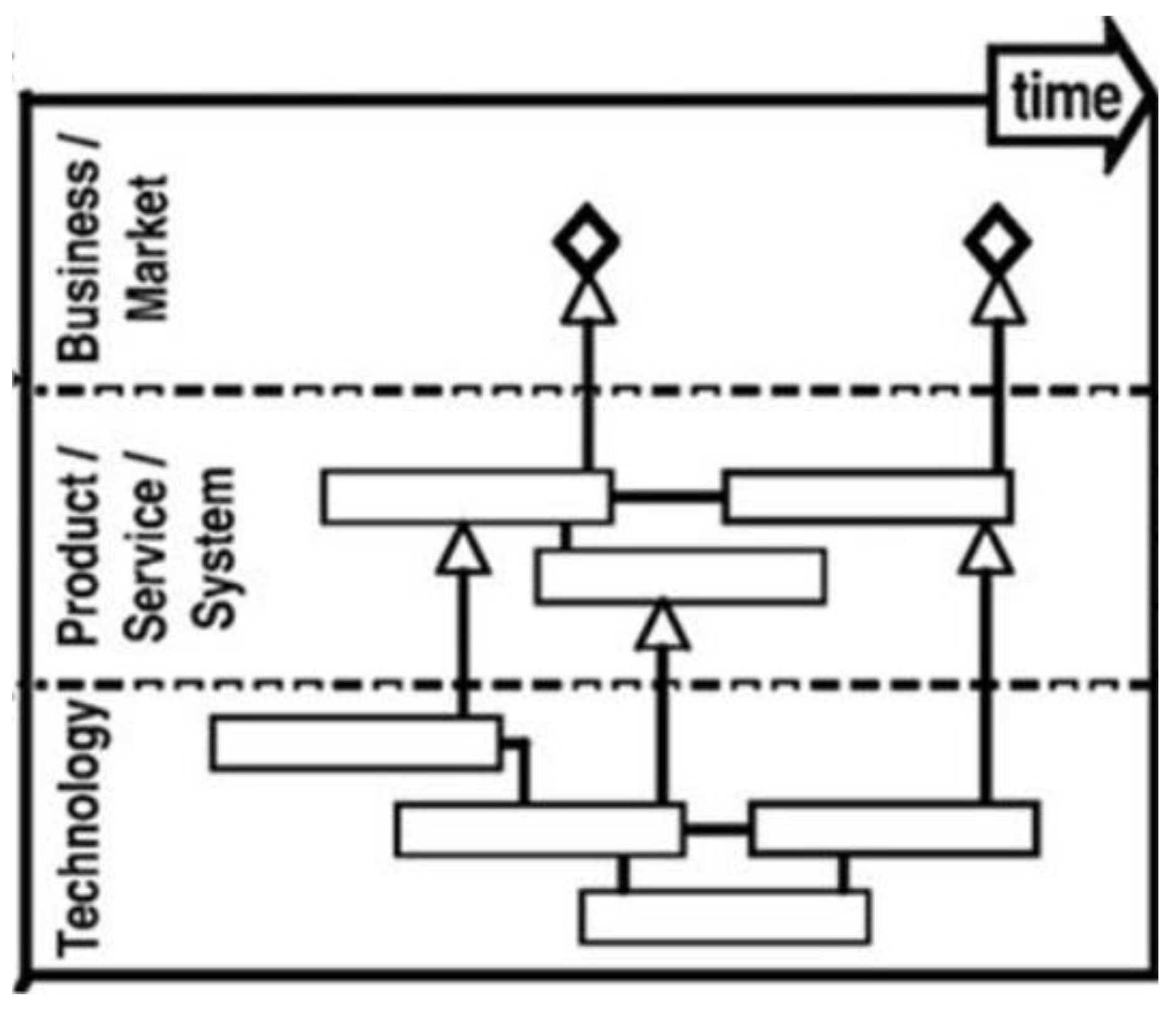
3.2. Policy-Technology Roadmap
| Type of policy tools | example | effect |
| Demand-side policy | Public procurement, price subsidies. | Stabilize the market environment for innovation, fostering confidence and stimulating technology research and development. |
| Environmental policy | Standard design, goal planning. | Shape product development by setting performance norms, encouraging innovation, and facilitating industry transitions |
| Supply-side policy | technology infrastructure, technology input | Support enterprise research and development, encouraging investment and effective resource allocation |
4. Main layers of the Technology Roadmap
4.1. Technology
4.2. Product
| Research and Validation Stage | Early commercialization Stage | Rapid Commercialization Stage | Mature Commercialization Stage | |
| Driving mode | Autonomous driving technology awaits validation. | Requiring visual flight conducted by professional pilots in collaboration with assisted driving systems. | The system is responsible for most flight missions, equipped with professional pilots for manual control in emergency situations. | Passenger eVTOL achieve full autonomous flight, overseen remotely by a central control system, removing the requirement for onsite professional pilots. |
| Performance | Prototypes need to be explored through continuous experimentation and trial applications | The ideal performance parameters include a range of 150-200 kilometers, a cruising speed of 200-250 kilometers per hour, and a capacity of 4-5 passengers. | The emergence of second and third-generation commercial eVTOL products, and the larger size of eVTOL | A trend towards personalized design, with a variety of eVTOL designed and produced for different speeds, ranges, and appearances |
| Air traffic control | \ | Airspace and air traffic control systems have been adapted for low-altitude eVTOL flights, establishing fixed routes. Pre-approval from relevant authorities is required for flight missions. | Airspace management and air traffic control policies are becoming more flexible, with increased automation and shorter flight notification times. | The air traffic management system will be highly efficient, allowing airspace resources to be allocated on demand. |
| Infrastructure | \ | Landing and takeoff points are set up near traditional urban transport hubs. | Start spreading to urban commercial and residential centers and expanding into suburban areas. | eVTOL landing and takeoff points are integrated into urban planning. |
4.3. Market
| Stage | Consumer Groups | New Users | Characteristics |
| Research and Validation | Innovators | Technology pioneers, research institutions, aviation enthusiasts | -Interested in emerging technologies and new aircraft -Capable of investing significant resources into research and experimentation -Participate in research and testing processes |
| Early Commercialization | Early Adopters | Middle-income travelers, large corporations, affluent private users, individuals in need of air medical and tourism services | -Willing to try new products but more cautious compared to Innovators -Often have substantial incomes |
| Rapid Commercialization | Early Majority | Ordinary consumers, urban residents, business travelers | -Majority of consumers -Wait for evidence of reliability and effectiveness -Willing to pay reasonable prices -Concerned about convenience and practicality |
| Mature Commercialization | Late Majority and Laggards | Suburban users, conservative individuals | -Cautious about new technologies |
4.4. Policy
5. The Construction of the Technology Roadmap
5.1. Policy Role Dimensions at Different Commercialization Stages
5.2. Technology-Product Dimensions at Different Commercialization Stages
5.3. Products at Different Stages of Commercialization - Market Dimension
6. Further Analysis of the TRM
6.1. Analysis by DEMATEL
| M11 | M12 | M13 | M21 | M22 | M23 | P1 | P2 | P3 | P4 | T1 | T2 | T3 | T4 | G1 | G2 | G3 | G4 | |
| M11 | 1 | 1 | 1 | |||||||||||||||
| M12 | 1 | 1 | ||||||||||||||||
| M13 | ||||||||||||||||||
| M21 | 1 | |||||||||||||||||
| M22 | 1 | |||||||||||||||||
| M23 | ||||||||||||||||||
| P1 | 1 | |||||||||||||||||
| P2 | 1 | 1 | 1 | |||||||||||||||
| P3 | 1 | 1 | 1 | |||||||||||||||
| P4 | 1 | 1 | ||||||||||||||||
| T1 | 1 | 1 | ||||||||||||||||
| T2 | 1 | 1 | 1 | |||||||||||||||
| T3 | 1 | 1 | 1 | |||||||||||||||
| T4 | 1 | |||||||||||||||||
| G1 | 1 | 1 | ||||||||||||||||
| G2 | 1 | 1 | ||||||||||||||||
| G3 | 1 | 1 | ||||||||||||||||
| G4 | 1 | 1 |
| M11 | M12 | M13 | M21 | M22 | M23 | P1 | P2 | P3 | P4 | T1 | T2 | T3 | T4 | G1 | G2 | G3 | G4 | |
| M11 | 0.444 | 0.235 | 0.444 | 0.235 | 0.333 | 0.259 | ||||||||||||
| M12 | 0.444 | 0.111 | 0.333 | |||||||||||||||
| M13 | ||||||||||||||||||
| M21 | 0.333 | 0.111 | ||||||||||||||||
| M22 | 0.333 | |||||||||||||||||
| M23 | ||||||||||||||||||
| P1 | 0.111 | 0.086 | 0.055 | 0.111 | 0.123 | 0.067 | 0.333 | 0.148 | 0.078 | |||||||||
| P2 | 0.333 | 0.259 | 0.165 | 0.333 | 0.370 | 0.202 | 0.444 | 0.235 | ||||||||||
| P3 | 0.333 | 0.259 | 0.333 | 0.259 | 0.444 | |||||||||||||
| P4 | 0.333 | 0.333 | ||||||||||||||||
| T1 | 0.148 | 0.165 | 0.128 | 0.148 | 0.214 | 0.144 | 0.444 | 0.346 | 0.219 | 0.333 | 0.111 | 0.037 | ||||||
| T2 | 0.111 | 0.235 | 0.219 | 0.111 | 0.272 | 0.232 | 0.333 | 0.593 | 0.424 | 0.333 | 0.111 | |||||||
| T3 | 0.111 | 0.235 | 0.111 | 0.235 | 0.333 | 0.593 | 0.333 | |||||||||||
| T4 | 0.111 | 0.111 | 0.333 | |||||||||||||||
| G1 | 0.086 | 0.133 | 0.116 | 0.086 | 0.162 | 0.125 | 0.259 | 0.313 | 0.214 | 0.333 | 0.444 | 0.148 | 0.049 | |||||
| G2 | 0.037 | 0.115 | 0.151 | 0.037 | 0.128 | 0.155 | 0.111 | 0.309 | 0.339 | 0.333 | 0.444 | 0.148 | ||||||
| G3 | 0.111 | 0.198 | 0.111 | 0.198 | 0.333 | 0.481 | ||||||||||||
| G4 | 0.333 | 0.444 | 0.148 |
| Effect degree (r) | Cause degree (c) | Prominence (r+c) | Relation (r-c) | Weight | |
|---|---|---|---|---|---|
| M11 | 1.951 | 0.827 | 2.778 | 1.123 | 0.057 |
| M12 | 0.889 | 1.993 | 2.882 | -1.104 | 0.059 |
| M13 | 0.000 | 2.649 | 2.649 | -2.649 | 0.054 |
| M21 | 0.444 | 1.160 | 1.605 | -0.716 | 0.033 |
| M22 | 0.333 | 3.047 | 3.380 | -2.713 | 0.069 |
| M23 | 0.000 | 3.000 | 3.000 | -3.000 | 0.061 |
| P1 | 1.114 | 0.000 | 1.114 | 1.114 | 0.023 |
| P2 | 2.342 | 1.481 | 3.823 | 0.860 | 0.078 |
| P3 | 1.630 | 3.152 | 4.782 | -1.523 | 0.098 |
| P4 | 0.667 | 3.954 | 4.620 | -3.287 | 0.095 |
| T1 | 2.439 | 0.333 | 2.772 | 2.105 | 0.057 |
| T2 | 2.974 | 1.111 | 4.085 | 1.863 | 0.084 |
| T3 | 1.951 | 1.037 | 2.988 | 0.914 | 0.061 |
| T4 | 0.556 | 0.679 | 1.235 | -0.123 | 0.025 |
| G1 | 2.471 | 0.000 | 2.471 | 2.471 | 0.051 |
| G2 | 2.308 | 0.000 | 2.308 | 2.308 | 0.047 |
| G3 | 1.432 | 0.000 | 1.432 | 1.432 | 0.029 |
| G4 | 0.926 | 0.000 | 0.926 | 0.926 | 0.019 |
6.2. Crossing the Chasm
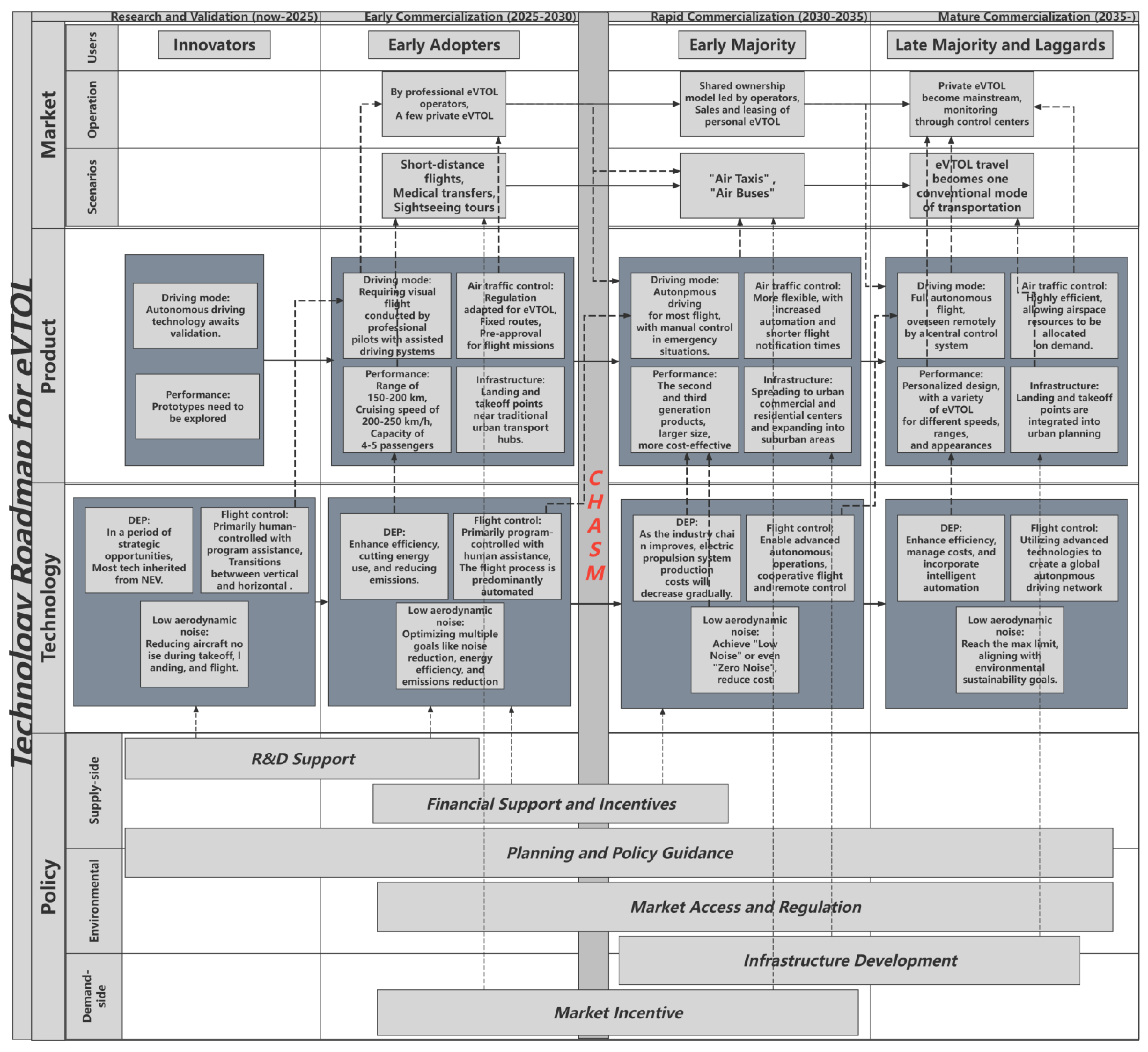
7. Conclusions
| Aspect | Strategies |
|---|---|
| Technical Feasibility | - Develop advanced electric flight technology, including high-energy-density batteries, efficient electric motors, and intelligent power management systems. - Research and deploy infrastructure for flexible takeoff and landing . - Ensure sufficient flight range and passenger capacity. |
| Safety | - Implement advanced automatic flight systems, including automatic takeoff and landing, obstacle detection and avoidance, and flight path planning. - Enhance emergency handling capabilities, such as automatic switching to backup power and emergency landing procedures. |
| Affordability | - Reduce manufacturing and operating costs through improvements in materials, production processes, scale production, and supply chain management. - Realize and apply fully automatic flight to minimize training and employment costs for professional pilots. - Ensure price competitiveness to attract mainstream customers’ purchases. |
| Governmental Policies | - Strategically direct policy support towards facilitating the crossing of the chasm. - Overcome obstacles and streamline policy guidance and support for eVTOL to foster low-altitude economy development. |
Acknowledgments
References
- Goyal, R., Reiche, C., Fernando, C., Serrao, J., Kimmel, S., Cohen, A., and Shaheen, S., Urban Air Mobility (UAM) Market Study[R]. 20190001472, National Aeronautics and Space Administration, Washington, D.C., 2018.
- Hideki K. Development trends and prospects for eVTOL:a new mode of air mobility[R]. Mitsui & Co. Global Strategic Studies Institute Monthly Report,2018.
- Du Wei, Sun Na. Research on development status of eVTOL [J]. Aeronautical Science & Technology,2021,32 (11): 1-7. [CrossRef]
- EASA, Proposed Special Condition for small-category VTOL aircraft[R]. Vol. SC-VTOL-01, European Aviation Safety Agency, Brussels, 2018.
- UGWUEZE O, STATHEROS T, BROMFIELD MA, et al. Trends in eVTOL aircraft development: The concepts, enablers and challenges[C].Proceedings of the AIAA Scitech 2023 Forum. Reston: AIAA,2023. [CrossRef]
- DENG J H. Technical status and development of electric vertical take-off and landing aircraft[J]. Acta Aeronautica et Astronautica Sinica,2024,45(5):529937.
- Wang Xiangyu. The Future of Urban Air Mobility Market Development[J].Aerospace Power,2019(04):18-21. https://kns.cnki.net/kcms2/article/abstract?v=mjz80qGfPOXWapJAsY5ylA9PstP2yiehilg3vUsarXUPQqk6nCXrgYX6woouXZ8UDecB_8zcpEx82saY4iAj0Mf1AMWx8W0EAstyWE-xcRHDvn518zLES14e0wsKhNjoOm4Br8yb03U=&uniplatform=NZKPT&language=CHS.
- Marie L.Garcia,Olin H.Bray.Fundamentals of Technology Roadmapping[R].Albuquerque, New Mexico 87185 and Livermore, California, USA: Sandia National Laboratories,1997. [CrossRef]
- Phaal, R., Farrukh, C. J., & Probert, D. R. Technology roadmapping—A planning framework for evolution and revolution[J]. Technological Forecasting and Social Change, 2004, 71(1–2), 5-26. [CrossRef]
- Kostof, R. N., & Schaller, R. R. Science and technology roadmaps[J]. IEEE Transactions on Engineering Management, 2001, 48(2), 132-143. [CrossRef]
- Phaal, R., Farrukh, C. J., & Probert, D. R. Strategic roadmapping: A workshop-based approach for identifying and exploring strategic issues and opportunities[J]. Engineering Management Journal, 2007, 19(1), 3-12. [CrossRef]
- Phaal, R., & Muller, G. An architectural framework for roadmapping: Towards visual strategy[J]. Technological Forecasting and Social Change, 2009, 76(1), 39–49. [CrossRef]
- HUANG Cui,XU Lei,ZHONG Xiao-tian,SU Jun.A Framework of Integrated Policy-Technology Roadmap ( P-TRM) and Its Use:Examples of Wind Turbine and Solar PV Industries[J].China Soft Science: 2014(5), 76-84. https://kns.cnki.net/kcms2/article/abstract?v=mjz80qGfPOWjAjMWliskn2afH5rNiBstflMScY1YZ_XPPswEEyYubMBhzt_ooGa85RGVCVekkBfI1kTFzKUvCplap7LmyNuELH0FtYZ3JYIwpmOGaOSSzIMyEGM-czvs&uniplatform=NZKPT&language=CHS.
- Han Quanquan, Xi Qingbiao, Liu Huixia, et al. Based on unmanned aerial vehicle (uav) control technology development trend of flight safety study [J]. Journal of modern electronic technology, 2014 37(13) : 22-25. [CrossRef]
- China Southern Airlines General Aviation Co., Ltd., Shanghai Volant Aerospace Technology Co., Ltd..White Paper on Passenger eVTOL Applications and Markets[R].Shanghai, China:2023.
- Rogers, E. Diffusion of innovations[M].1962. Free Press, London, NY, USA.
- Moore G A. Crossing the Chasm, 3rd Edition[M]. 2014.HarperCollins Publishers,New York, USA.
- Hu Wen, Xia Beil. A Framework of Policy-technology Roadmap of Disruptive Technology: A Case of New Energy Vehicle Industry in China[J]. Science & Technology Progress and Policy, 2024 (41), 2: 25-34. https://kns.cnki.net/kcms2/article/abstract?v=mjz80qGfPOU_2e9EHapjNr97rVUgaLOpHL7A9do9OYQvru0JGlU2-F8lE_I2E9gRjGnk0779tfpF783asVNB8KXRBi61LVDcyL0qZN0ufDx5TNOKLlMY9Xs5FWH1RNbwdIStVR_DEko=&uniplatform=NZKPT&language=CHS.
- Si, Sheng-Li, et al. “DEMATEL technique: A systematic review of the state-of-the-art literature on methodologies and applications.” Mathematical Problems in Engineering 2018 (2018): 1-33. [CrossRef]
- Alinezhad, Alireza, et al. “DEMATEL method.” New Methods and Applications in Multiple Attribute Decision Making (MADM) (2019): 103-108. [CrossRef]
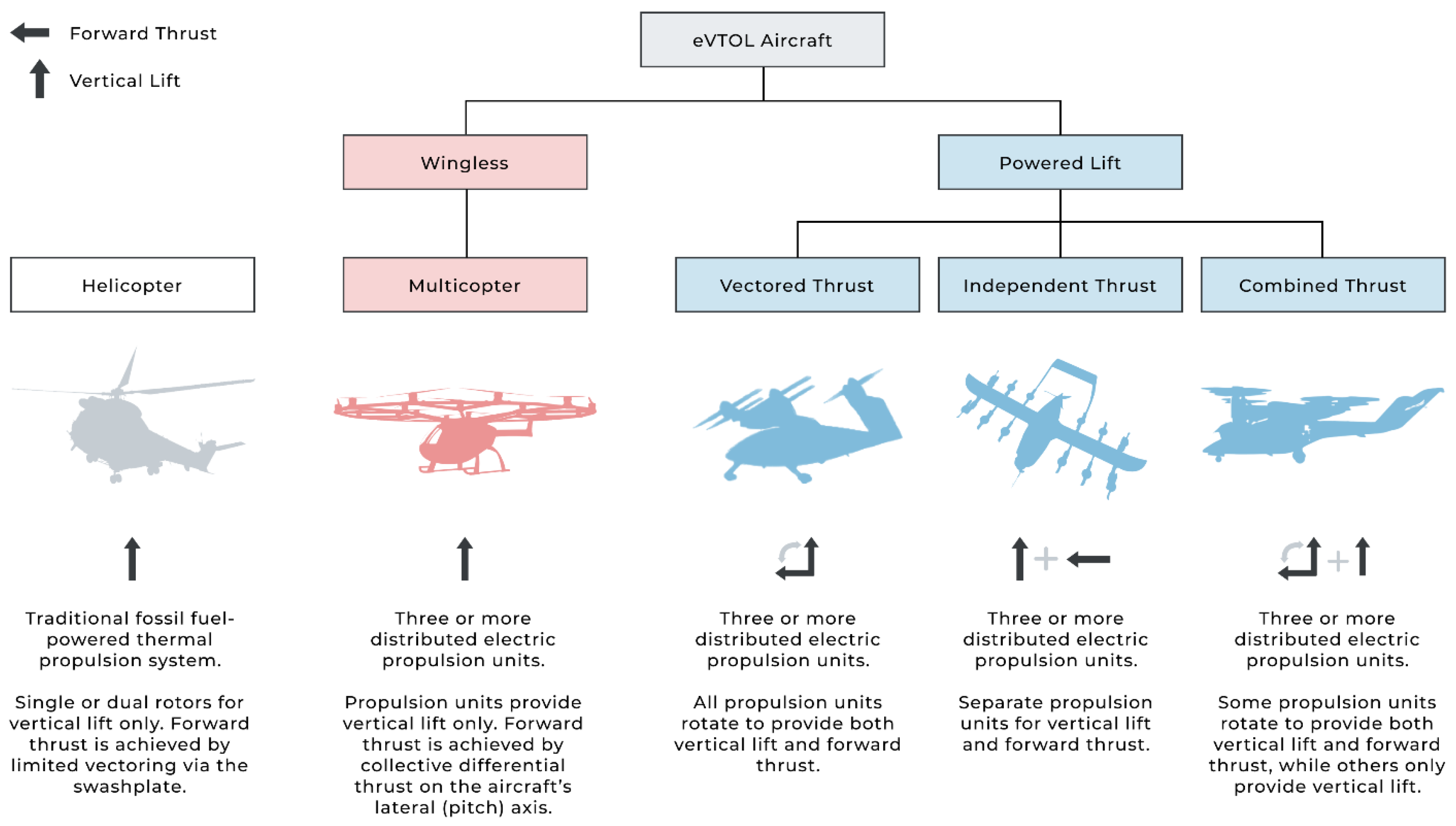
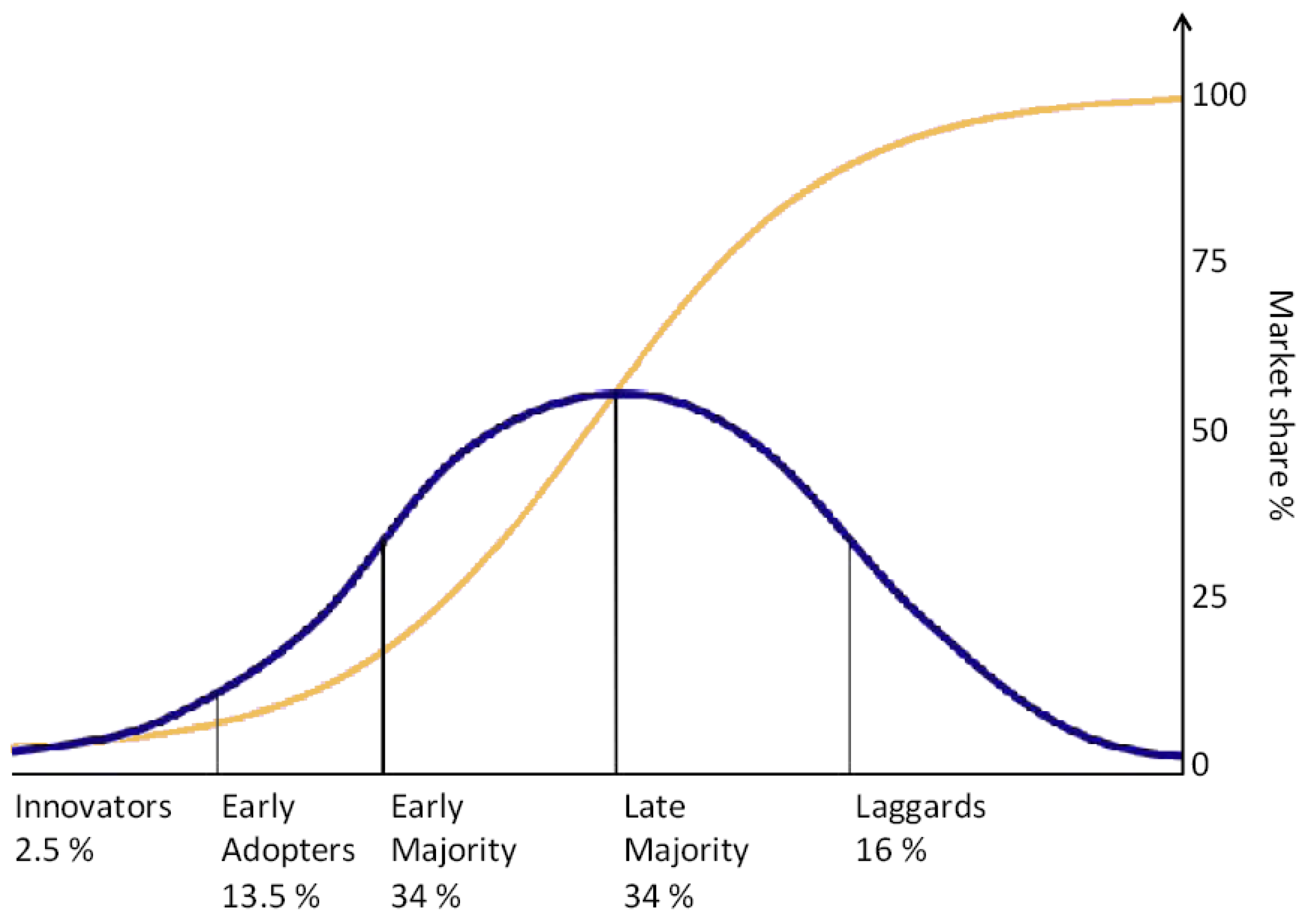
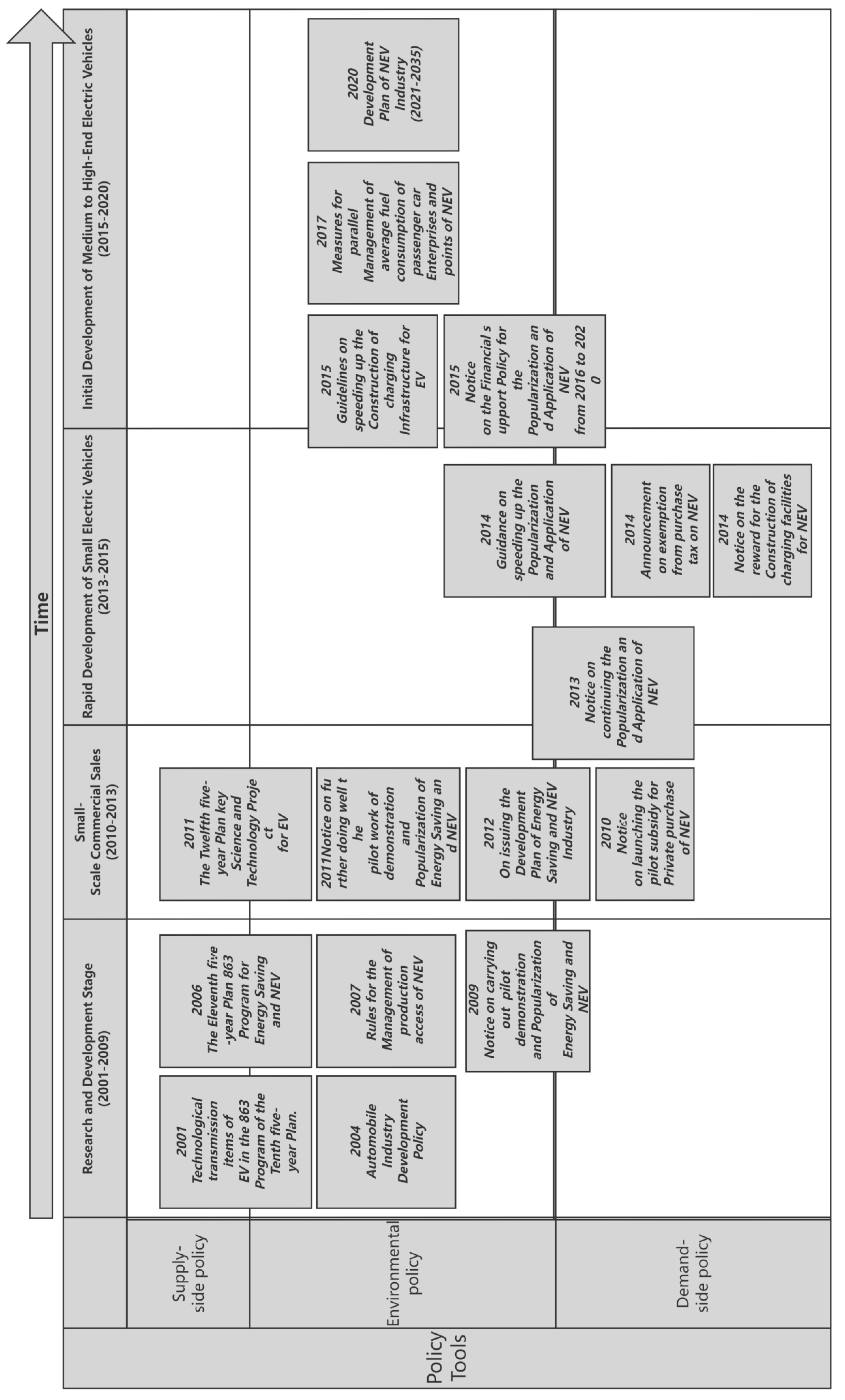
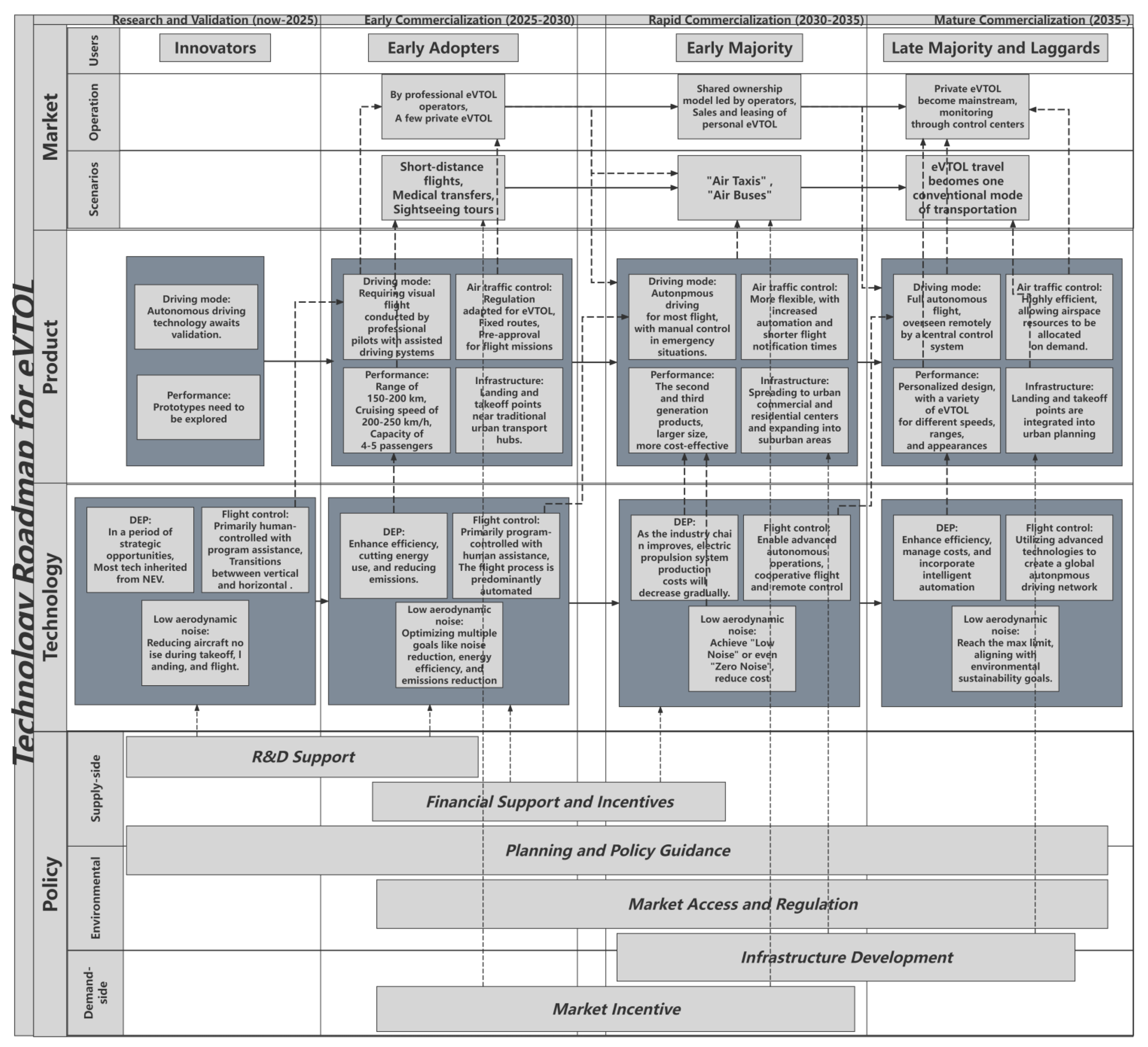
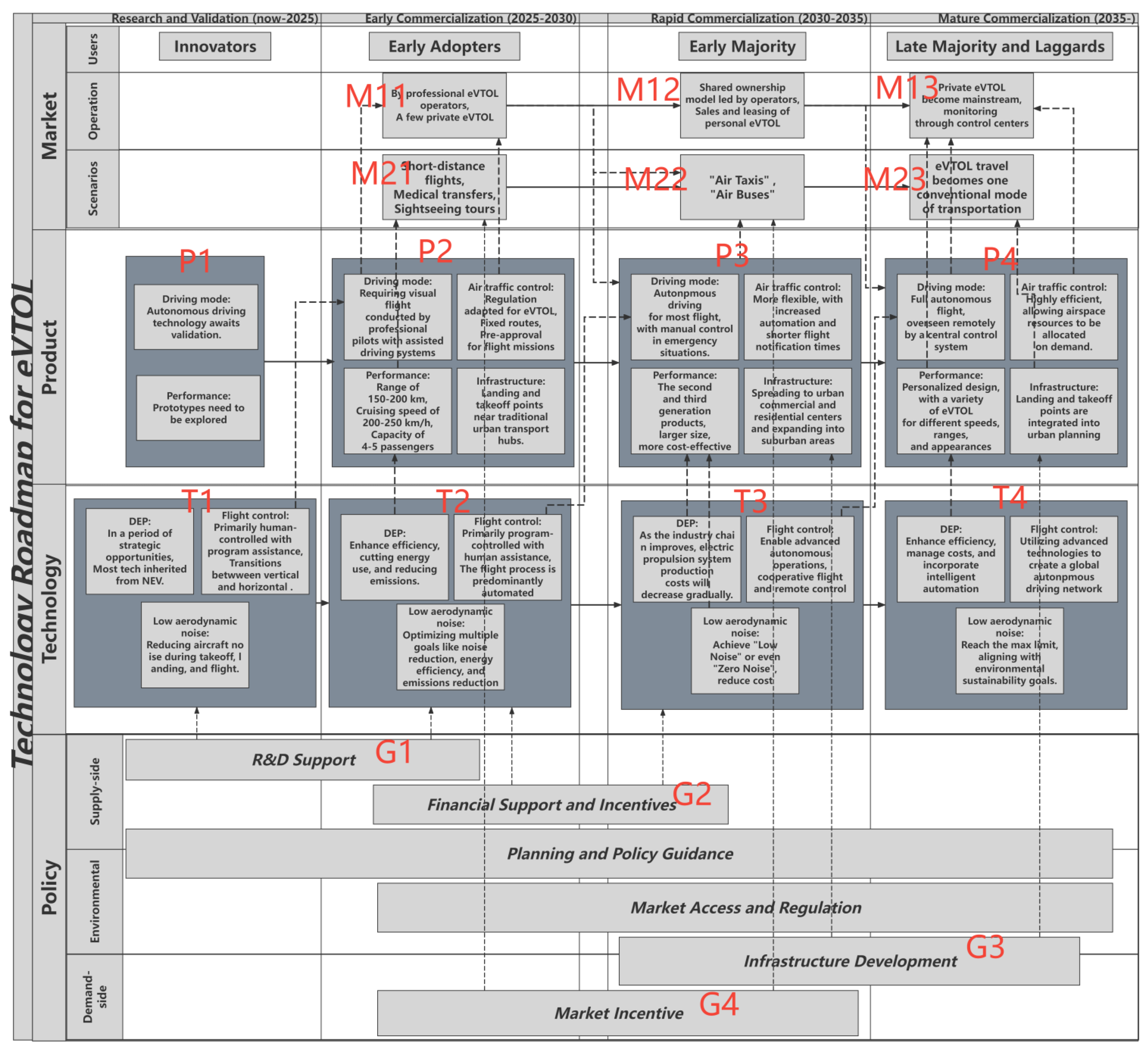
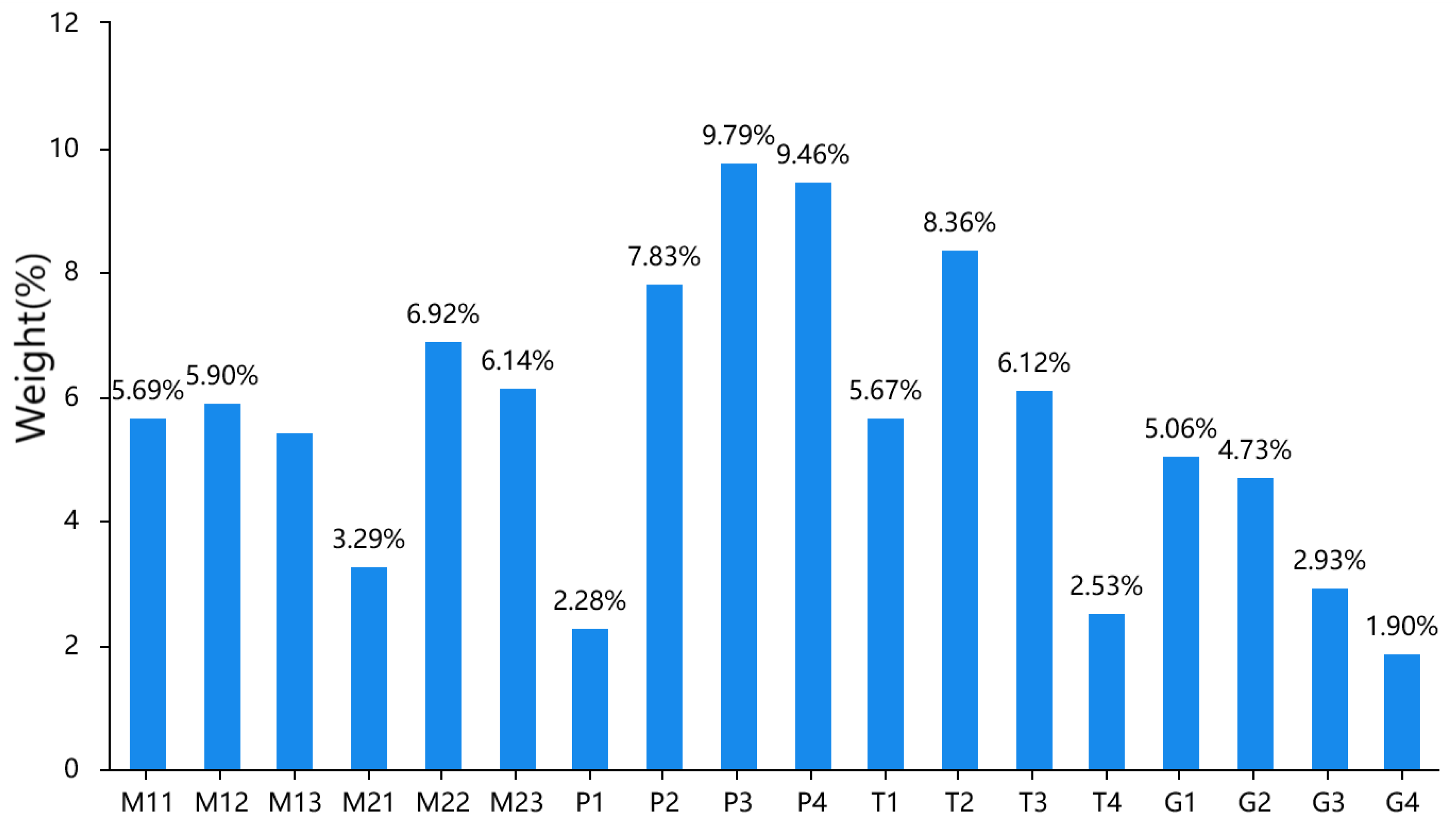

| Research and Validation | Early Commercialization | Rapid Commercialization | Mature Commercialization | |
| Distributed Electric Propulsion | In a period of Strategic opportunities, Most tech inherited from NEV. |
Enhance efficiency, cutting energy use, and reducing emissions. | As the industry chain improves, electric propulsion system production costs will decrease gradually. | Enhance efficiency, manage costs, and incorporate intelligent automation |
| Low Aerodynamic Noise Technology | Reducing aircraft noise during takeoff, landing, and flight. | Optimizing multiple goals like noise reduction, energy efficiency, and emissions reduction | Achieve “Low Noise” or even “Zero Noise”, reduce cost | Reach the max limit, aligning with environmental sustainability goals. |
| Flight Control Technology | Primarily human-controlled with program assistance. | Primarily program-controlled with human assistance, The flight process is predominantly automated | Enable advanced autonomous operations, cooperative flight and remote control | Utilizing advanced technologies to create a global autonomous driving network |
Disclaimer/Publisher’s Note: The statements, opinions and data contained in all publications are solely those of the individual author(s) and contributor(s) and not of MDPI and/or the editor(s). MDPI and/or the editor(s) disclaim responsibility for any injury to people or property resulting from any ideas, methods, instructions or products referred to in the content. |
© 2024 by the authors. Licensee MDPI, Basel, Switzerland. This article is an open access article distributed under the terms and conditions of the Creative Commons Attribution (CC BY) license (http://creativecommons.org/licenses/by/4.0/).




